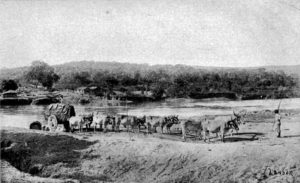Some day take a drive north on Highway 34 toward Wolfe City. When you see FM 1566, turn left and drive down a slight hill to the old community of White Rock. The area is truly unique to Hunt County and the Blackland Prairies. The name White Rock refers to an outcropping of Austin Chalk that is close to the top of the ground in that area.
Originally the community was a camping place and later became known as Tidwell Creek. It was on the Old Sherman and Jefferson Trail, part of the Jefferson Road that began in the town of Jefferson, the second largest port in Texas at one time. The Jefferson Road entered Hunt County west of Cumby and split near Brigham Cemetery. The main road arched into Greenville along what was later the East Line and Red River Railroad or the Texas Midland Line. The auxiliary road went on to Sherman through Whitewright and Kentucky Town.
Freighters hauled goods mostly by ox teams on heavy freight wagons. Some used teams of mules. In muddy winter and spring weather, the wagons did good to travel two or three miles per day.
On the first Hunt County tax roll in 1846 Jonas Havens was listed as the first settler in the area. On August 28, 1857 Henry Pinney received a patent to establish the seventh post office in the county. It was known as Tidwell Creek. The following year Tennessean John M. Tittsworth started a school in White Rock. No exact date was found as to the time of the name change.
The first store in the area was a general store operated by Lem Kennedy. Kennedy and John Kiser ran the first saloon. Later a barbershop opened. By the beginning of the Civil War about ten families lived in the area.
In the 1870s the White Rock School had a large number of students. Some of the children came from as far as ten miles away. Their fathers blazed a trail through the thick timber. By 1890 the school had expanded to a two-story building with five teachers required for the large student population.
White Rock was a busy place with ten stores, two saloons, a blacksmith shop, a mill, and the cotton gin. Later the community boasted two telephone systems. Claud Lowry owned one of the telephone lines with a switchboard serving about seventy-five customers.
In the early days there were no churches at White Rock, but itinerant preachers held services in private homes when they passed through the area. The Pleasant View Baptist Church was organized in 1871 about a mile west of White Rock. In 1901 the membership voted to move to White Rock and changed the name to White Rock Baptist Church.
The Methodist Church met in the school until a church building was finished in 1898. In 1907 the church was damaged in a storm but quickly rebuilt. In 1920 Henry Grady May organized an orchestra for the church.
When railroads in the late 19th century chose to service Kingston and Celeste, White Rock began a decline. Businesses moved away, followed by families. Today White Rock is a small community in a lovely setting, well worth a drive there.


Would you happen to know the name of the old gin? We have been searching forever for a picture. Our whole family is from Tidwell Creek and we are wanting to find an image of the Gin for a book.